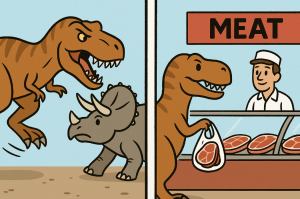
Nanotyrannus Discovery and Its Impact on Understanding Tyrannosaur Evolution
The recent discovery of a fossil in a North Carolina museum has ignited the scientific community, confirming the existence of Nanotyrannus as a distinct species rather than a juvenile Tyrannosaurus rex. This finding, stemming from thorough analysis, redefines how we perceive tyrannosaur diversity and evolution during the Cretaceous period (NYTimes & Natural Sciences)
The Remarkable Discovery
For decades, the paleontological world has been divided over whether Nanotyrannus was a distinct species or merely a “teenage” T. rex. However, the discovery of a nearly complete fossil has settled this long-standing debate. This fossil highlights the existence of Nanotyrannus lancensis as a distinct species that coexisted with the towering Tyrannosaurus rex, thereby altering the narrative of dinosaur evolution.
Implications for Paleontology
This discovery reshapes our understanding of the dynamics within prehistoric ecosystems. Prior theories categorized these specimens as juvenile Tyrannosaurus rex, but this new evidence suggests that Nanotyrannus was not only distinct but also likely employed adapted strategies to survive alongside its more massive relatives.
- Competitive Evolution: Nanotyrannus was likely more agile and faster, filling an ecological niche distinct from the slow, lumbering T. rex.
- Ecological Dynamics: The presence of both T. rex and Nanotyrannus suggests a rich ecosystem with diverse predators cohabiting the same environment.
A Glimpse Into Prehistoric Life
The fossil, unearthed at the famous “dueling dinosaurs” site in Montana, presents a compelling case for re-examining other similar fossils, sparking further research, thereby unlocking more secrets of ancient life.
The Broader Impact of the Discovery
While this discovery satisfies the thirst for knowledge among dinosaur enthusiasts, it has broader implications: the now-confirmed genus Nanotyrannus provides insights into niche differentiation and the adaptability of tyrannosaurs during the rocky terrains of late Cretaceous North America.
As researchers continue to explore the fossil record, each new find like this redefines boundaries and possibilities, bringing dinosaurs back to life in the laboratory and fueling our imagination about our planet’s prehistoric past. The debate about Nanotyrannus is settled, but the opportunities for discovery are just beginning.



